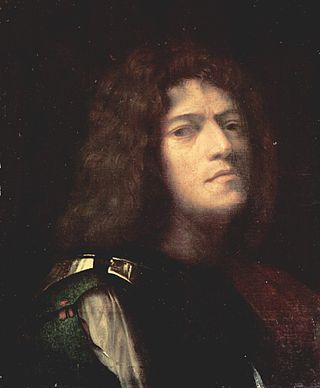
Giorgio Barbarelli da Castelfranco, known as Giorgione, was an Italian painter of the Venetian school during the High Renaissance, who died in his thirties. He is known for the elusive poetic quality of his work, though only about six surviving paintings are firmly attributed to him. The uncertainty surrounding the identity and meaning of his work has made Giorgione one of the most mysterious figures in European art.

Tiziano Vecellio, Latinized as Titianus, hence known in English as Titian, was an Italian Renaissance painter, the most important artist of Renaissance Venetian painting. He was born in Pieve di Cadore, near Belluno. During his lifetime he was often called da Cadore, 'from Cadore', taken from his native region.

Pietro Aretino was an Italian author, playwright, poet, satirist and blackmailer, who wielded influence on contemporary art and politics. He was one of the most influential writers of his time and an outspoken critic of the powerful. Owing to his communications and sympathies with religious reformers, he is considered to have been a Nicodemite Protestant. He was a good friend and publicist of the Venetian artist Titian, who painted his portrait three times.
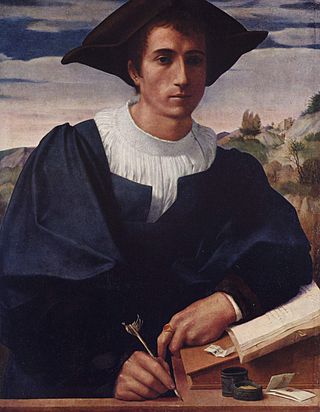
Franciabigio was an Italian painter of the Florentine Renaissance. His true name may have been Francesco di Cristofano; he is also referred to as either Marcantonio Franciabigio or Francia Bigio.

The Palazzo Vecchio is the town hall of Florence, Italy. It overlooks the Piazza della Signoria, which holds a copy of Michelangelo's David statue, and the gallery of statues in the adjacent Loggia dei Lanzi.
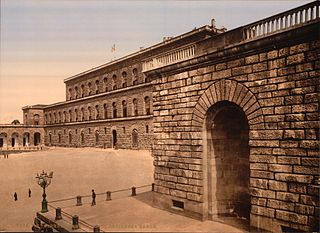
The Palazzo Pitti, in English sometimes called the Pitti Palace, is a vast, mainly Renaissance, palace in Florence, Italy. It is situated on the south side of the River Arno, a short distance from the Ponte Vecchio. The core of the present palazzo dates from 1458 and was originally the town residence of Luca Pitti, an ambitious Florentine banker.

Justus Sustermans, Joost Sustermans or Suttermans, his given name Italianised to Giusto, was a Flemish painter and draughtsman who is mainly known for his portraits. He also painted history and genre paintings, still lifes and animals.
Events from the year 1533 in art.

Leone Leoni was an Italian sculptor of international outlook who travelled in Italy, Germany, Austria, France, Spain and the Netherlands. Leoni is regarded as the finest of the Cinquecento medallists. He made his reputation in commissions he received from the Habsburg monarchs Charles V, Holy Roman Emperor and Philip II of Spain. His usual medium was bronze, although he also worked in marble and alabaster, carved gemstones and probably left some finished work in wax, as well as designing coins. He mainly produced portraits, and was repeatedly used by the Spanish, and also the Austrian, Habsburgs.

The Eleven Caesars was a series of eleven painted half-length portraits of Roman emperors made by Titian in 1536–1540 for Federico II, Duke of Mantua. They were among his best-known works, inspired by the Lives of the Caesars by Suetonius. Titian's paintings were originally housed in a new room inside the Palazzo Ducale di Mantova. Bernardino Campi added a twelfth portrait in 1562.
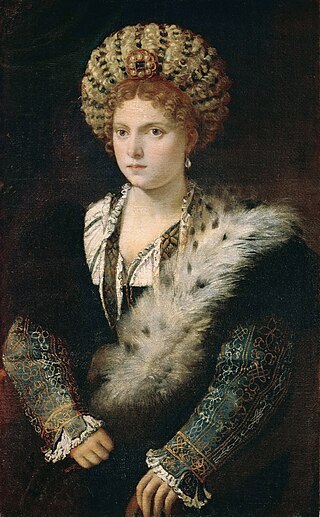
Portrait of Isabella d'Este is an oil on canvas painting of a young woman by Titian. It can be dated to the 1530s and is held in the Kunsthistorisches Museum, in Vienna. The artist and the date are undisputed. Beyond the museum documentation, there are several doubts about the person depicted.
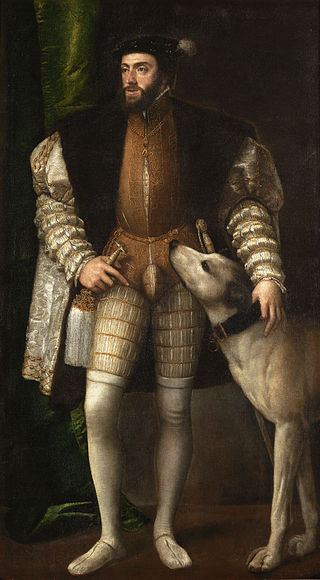
The Portrait of Charles V with a Dog is a portrait by Titian of Charles V, Holy Roman Emperor with a hunting dog, created in 1533. It passed from Charles to the Spanish royal collection, from which it came to the Museo del Prado, in Madrid.

La Bella is a portrait of a woman by Titian in the Palazzo Pitti in Florence. The painting shows the subject with the ideal proportions for Renaissance women. In parallel the stringent composition corresponds to Titian's real portraits. The work can be dated by a letter about "that portrait of that woman in a blue dress" in May 1536.

Portrait of a Young Englishman is an oil on canvas portrait by Titian, from c. 1540-1545. It is held in the Palazzo Pitti, in Florence. Its the uncertain that the portrait is really of an Englishman, he remains unidentified, but it may be in fact Henry Howard, or the Italians Ottavio Farnese or Ippolito Riminaldi.

The Portrait of Alvise Cornaro is a portrait by the Venetian painter Tintoretto, showing the man of letters Alvise 'Luigi' Cornaro. Datable to around 1560–1565, it was acquired by Leopoldo de' Medici and is now in the Galleria Palatina in Florence. For the time between the 1698 and 1829 inventories, it was mis-attributed to Titian.

Bindo Altoviti of the Altoviti family was an Italian banker and one of the most influential papal bankers of his generation. A patron of the arts, he cultivated close friendships with artists such as Benvenuto Cellini, Raphael, Michelangelo and Giorgio Vasari.

Portrait of a Knight of Malta is an oil on canvas painting by Titian, from c. 1515. It depicts a knight belonging to the Order of Malta. It is now in the Uffizi, in Florence.

Portrait of Giacomo di Andrea Dolfin, formerly known only as Portrait of a Man, is an oil painting by the Venetian master Titian, made about 1531. It is part of the collection of the Los Angeles County Museum of Art, though not currently on display.

Portrait of Pope Paul III with Camauro is a 1545 – 1546 oil on canvas painting by Titian, now in the Museo nazionale di Capodimonte in Naples.

Portrait of Charles V or Portrait of a Man Wearing the Order of the Golden Fleece is an oil on canvas painting by Titian, from c. 1549. It is held now in the Museo di Capodimonte, in Naples.


















